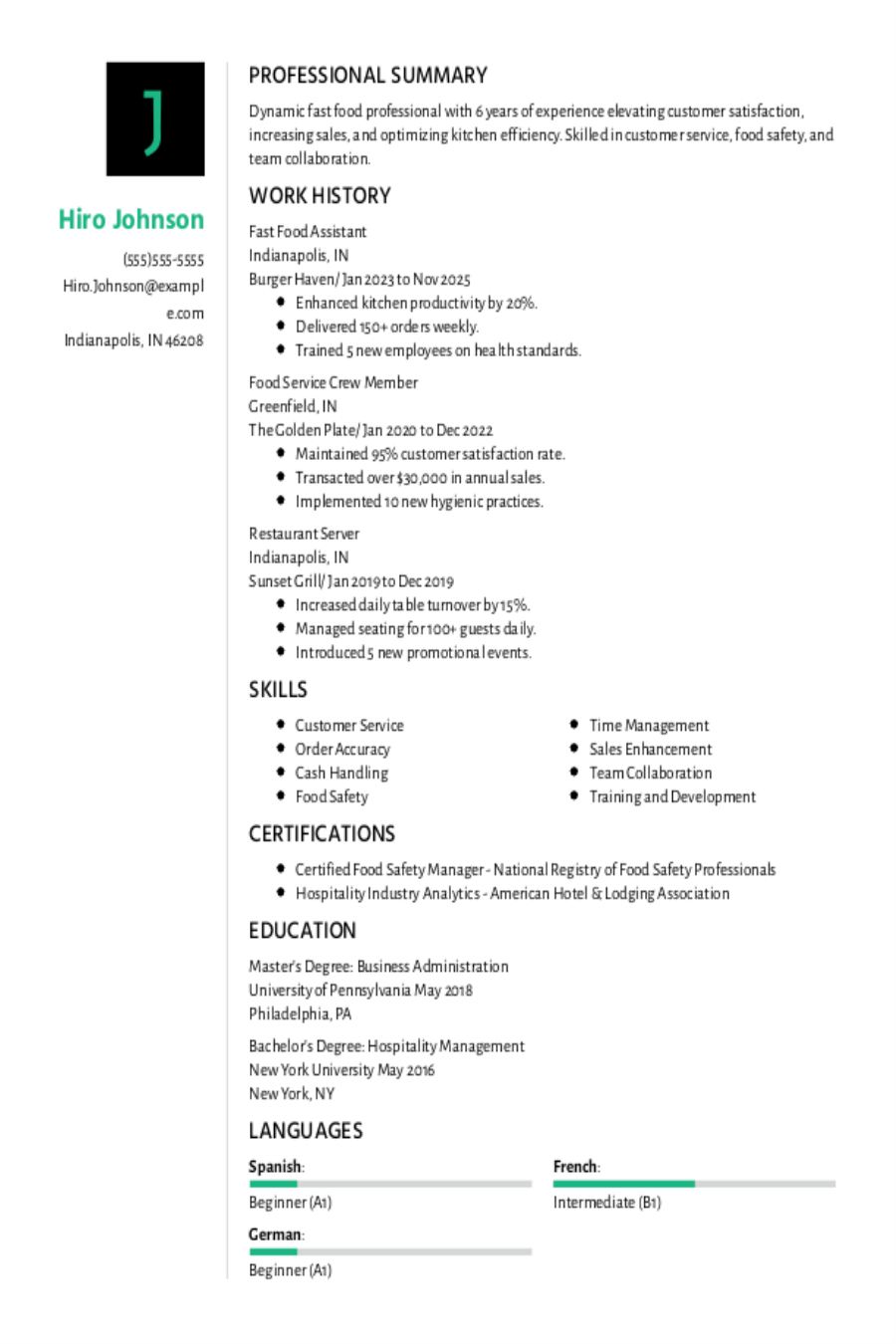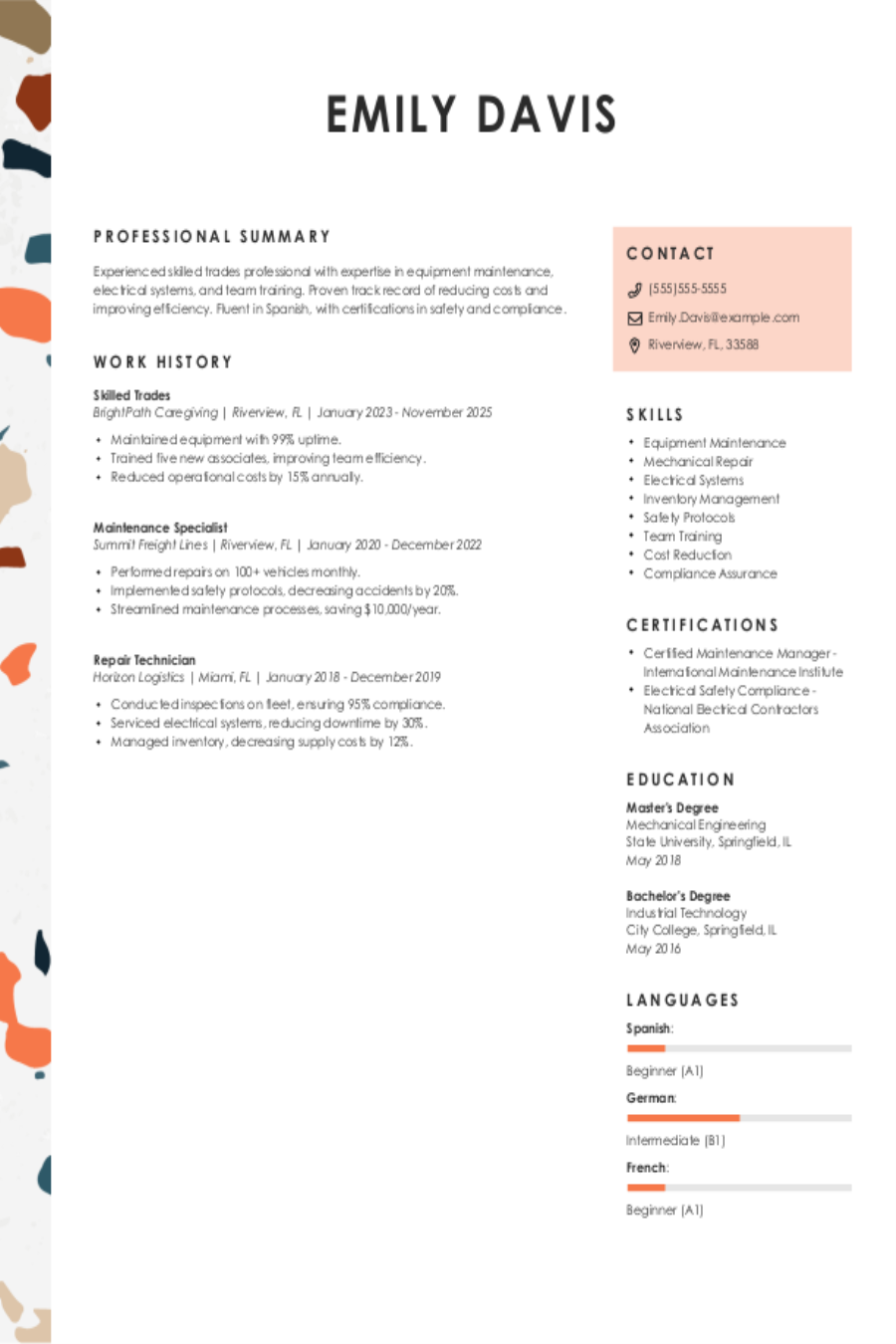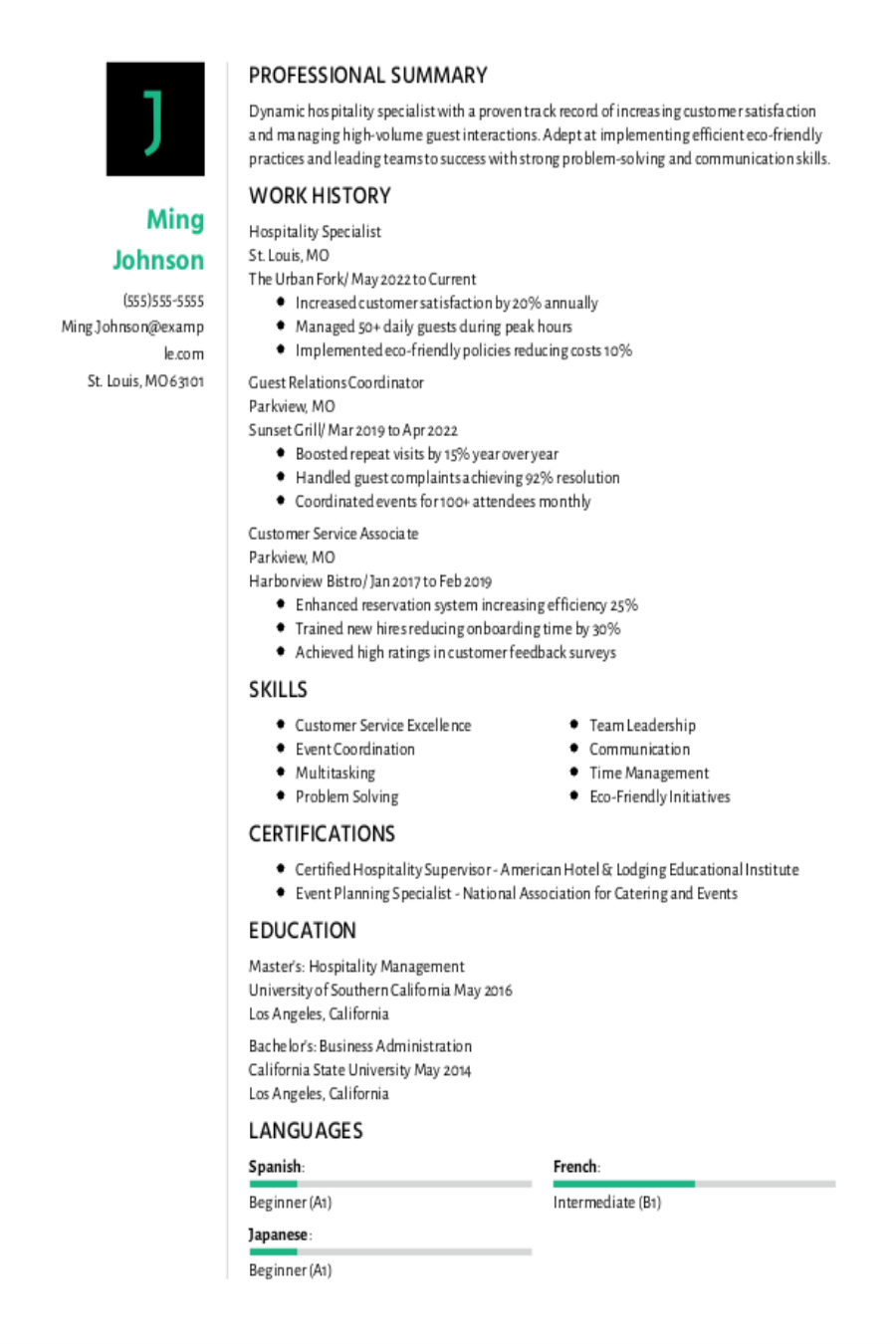Popular Assistant Professor Resume Examples
Entry-level assistant professor resume
An entry-level resume for an assistant professor should highlight academic achievements, teaching experience, relevant research, publications, and professional development to showcase expertise despite limited work history.
Showcases education: This resume builds the candidate’s credibility by placing a strong focus on their educational background, establishing their expertise despite limited experience.
Focuses on goals: The job seeker demonstrates a proactive approach to professional growth, with accomplishments in curriculum development and student engagement that highlight their dedication to improving educational experiences at the university level.
Mid-career assistant professor resume
A mid-career assistant professor's resume should emphasize a well-rounded mix of teaching experience, research accomplishments, and continuous professional development to demonstrate their impact in academia.
Includes mix of skills: This resume effectively highlights a balance of hard skills like data analysis and research methodologies, alongside soft skills such as student advisement and academic writing to illustrate comprehensive teaching capabilities.
Begins with a powerful summary: This resume's professional summary succinctly highlights the job seeker's extensive teaching and research experience. This clarity helps recruiters and ATS quickly recognize their qualifications.
Experienced assistant professor resume
An experienced assistant professor's resume should prioritize highlighting teaching effectiveness, research contributions, and service to the academic community to effectively demonstrate professional growth and impact.
Embraces modern design: This modern resume template effectively showcases the job seeker's commitment to excellence in academia, highlighting their innovative teaching methods and prolific research contributions to establish a robust professional brand.
Optimized for ATS: This resume's clean template merges a professional header with an ATS-friendly resume layout, optimizing visibility for both hiring authorities and software systems in academia.
No experience assistant professor resume
A resume for an applicant with no experience should highlight relevant skills, educational achievements, and any volunteer or internship experiences to showcase the job seeker's potential and enthusiasm for the role.
Overcomes lacking experience: Including extracurricular activities and volunteer experiences can improve a resume by showing commitment, transferable skills, and the ability to positively impact others, which are important for academic roles.
Uses a simple style: This resume's clean and streamlined format effectively highlights teaching skills, volunteer contributions, and academic achievements, making this candidate's qualifications easily accessible to reviewers.
More resume examples
Assistant Professor Resume Template
Looking to create a standout application? Start with this engaging assistant professor resume template, which you can easily personalize to reflect your unique qualifications and experience.
John Zhang
Parkview, MO 64158
(555)555-5555
John.Zhang@example.com
Professional Summary
Accomplished Assistant Professor specializing in curriculum development, with a proven track record of enhancing student engagement and publishing impactful research papers. Skilled in mentoring and delivering dynamic lectures, committed to educational advancement.
Skills
- Curriculum Development
- Research and Analysis
- Public Speaking
- Data Interpretation
- Student Assessment
- Mentoring
- Conference Presentation
- Academic Publishing
Certifications
- Certified Educator - National Educator's Association
- Advanced Teaching Techniques - American Teaching Institute
Education
Master of Science Computer Science
Harvard University Cambridge, Massachusetts
May 2017
Bachelor of Arts Mathematics
University of Illinois Urbana-Champaign, Illinois
May 2015
Work History
Assistant Professor
Springfield University - Parkview, MO
January 2023 - October 2025
- Developed curriculum for 5 courses
- Increased student engagement by 25%
- Published 10 research papers annually
Adjunct Lecturer
Central State College - St. Louis, MO
January 2020 - December 2022
- Presented 4 academic conferences
- Mentored 20 graduate students
- Improved departmental efficiency by 15%
Teaching Assistant
Greenwood University - St. Louis, MO
January 2018 - December 2019
- Assisted in grading 200 exams
- Led 2 lab sessions weekly
- Co-authored 3 research articles
Languages
- Spanish - Beginner (A1)
- French - Beginner (A1)
- German - Intermediate (B1)
Must-Have Skills on an Assistant Professor Resume
A strong skills section is essential for showcasing your qualifications and improving your resume’s effectiveness.
Education and training professionals play a vital role in fostering growth and development. The skills you highlight should reflect your ability to support learning and guide others toward success. Your resume is your opportunity to demonstrate how you contribute to progress and positive outcomes in learning environments.
The following data highlights the key hard and soft skills relevant to academic positions based on extensive research from various educational institutions.
When you're ready to refine your skills list, check out our AI Resume Skills Generator. It tailors suggestions of both hard and soft skills specifically for your job title, ensuring a comprehensive and unique skill profile.
Writing Your Assistant Professor Resume
Having explored these effective resume examples, you're now prepared to dive into the process of how to write a resume. We'll walk you through every section methodically, ensuring you understand each component as we go along.
List your most relevant skills
An effective skills section on your assistant professor resume should focus on both hard and soft skills relevant to the academic environment, such as research methodologies and student engagement techniques. By carefully analyzing the job listing, you can identify keywords from the job listing that highlight your expertise and align with the institution's needs.
Including these keywords not only attracts human recruiters but also ensures you pass through applicant tracking systems. Tailoring your skills section in this way clearly communicates your fit for the role, making it easier for potential employers to see how you meet their requirements.
Example of skills on an assistant professor resume
- Proficient in delivering engaging lectures and presentations to diverse student groups
- Experienced in curriculum development and academic program design
- Strong mentor with a commitment to fostering student success and engagement
- Skilled in conducting compelling research and publishing scholarly articles
A strong skills section should highlight both hard and soft skills, showcasing an applicant's readiness for technical tasks as well as their ability to communicate effectively, collaborate with teammates, and manage client interactions seamlessly.
Highlight your work history
Your work experience section should not only outline your responsibilities but also emphasize your achievements and contributions to academic settings. Use this opportunity to showcase how you've applied your expertise in teaching, research, and service, ensuring you include relevant keywords that align with the job description.
For each position you've held, it's essential to provide specific information such as your title, the institution's name, and the dates of employment. This clarity helps hiring committees understand your professional timeline and credibility within the academic community.
Example of an assistant professor work experience entry
- Assistant Professor
University of Texas - Austin, TX
August 2019 - Present - Develop and deliver engaging undergraduate and graduate-level courses in Psychology, achieving a student satisfaction rate of 96%
- Conduct innovative research leading to publications in peer-reviewed journals, improving the department's academic reputation
- Supervise and mentor over 10 graduate students through their thesis projects, fostering their professional development and academic success
- Collaborate with faculty on interdisciplinary initiatives, contributing to grant proposals that secured $500,000 in funding for research programs
- Organize departmental seminars and workshops to promote knowledge sharing and networking among students and professionals
Quantifying achievements as an assistant professor is essential for illustrating your impact on student learning and institutional goals. For example, stating that you increased student engagement in your courses by 40% through innovative teaching methods provides clear evidence of your effectiveness as an educator.
Include your education
The education section of your assistant professor resume should display your academic credentials in reverse-chronological order, starting with the most recent degree. Include all relevant degrees and certifications while omitting your high school diploma if you hold a higher qualification.
If you are currently enrolled in a program or have not completed your education, list the highest degree achieved along with an expected graduation date. Consider including bullet points that detail relevant coursework or noteworthy academic achievements, particularly if you are a recent graduate or still pursuing advanced studies.
Common certifications for an assistant professor resume
- Certified Teacher (CT) – National Board for Professional Teaching Standards (NBPTS)
- Master Teacher Certification (MTC) – American Association of Colleges for Teacher Education (AACTE)
- National Board Certified Teacher (NBCT) – National Board for Professional Teaching Standards (NBPTS)
- Teaching English as a Second Language (TESOL) – Teachers of English to Speakers of Other Languages
Showcase publications and research
For an assistant professor, showcasing your publications is essential as they show your academic contributions and research expertise. Publications not only reflect your mastery of the subject matter but also demonstrate your ability to engage with the scholarly community, making it clear to potential employers that you're active in your field.
When deciding how to list your publications, consider creating a dedicated publications section on your resume if you have several significant works. This allows you to highlight them prominently. If space is limited or if you only have one or two notable publications, integrating them into your education or experience can work better.
Example of a publications section
- Williams, R. & Patel, S. (2024). "Innovative Teaching Methods in Higher Education". Journal of Educational Development, 18(3), 210-225.
- Anderson, K., Williams, R., & Lee, T. (2023). "The Role of Technology in Modern Classrooms". Education Technology Review, 9(1), 45-60.
- Research Contributor, University Teaching Excellence Initiative (2022–2023). "Pedagogical Strategies Research Contribution". Led curriculum design research for innovative teaching methods.
- Chen, H., Williams, R., et al. (2022). "Collaborative Learning Models for Improved Student Engagement". Higher Education Journal, 20(5), 345-360.
Sum up your resume with an introduction
Creating a compelling resume profile section is essential for making a strong first impression. This section serves as your introduction, allowing hiring managers to quickly grasp your qualifications and what you bring to the table.
If you have substantial experience, consider using a professional summary to showcase your key achievements. This format allows you to highlight specific skills and experiences that align with the job requirements, providing clear evidence of your capabilities. If your professional experience is minimal, write a resume objective that shows your intent to grow and contribute.
Professional summary example
Accomplished assistant professor with over 10 years of experience in higher education. Demonstrated success in improving student engagement through innovative teaching methods and curriculum development. Expertise in research methodologies, academic writing, and collaborative projects, fostering a dynamic learning environment for diverse student populations.
Resume objective example
Enthusiastic assistant professor eager to use strong communication, research, and curriculum development skills to foster an engaging learning environment. Committed to improving student success and promoting innovative teaching methods while actively contributing to departmental goals.
As an assistant professor applicant, your resume profile should be concise and packed with essential information. Aim for no more than three sentences that highlight your key qualifications. To keep things clear and focused on what matters most, save any additional details for your cover letter.
Add unique sections to set you apart
Optional resume sections can help you highlight your unique qualifications as an assistant professor. These sections are a great opportunity to showcase the diverse experiences that make you stand out.
Including information about relevant hobbies, research projects, or volunteer work allows you to present different facets of your professional persona. This not only reflects your skills but also reveals your personal values and commitment to education. By sharing these aspects, you give employers a fuller picture of who you are as an educator and community member, improving your candidacy in a competitive field.
Three sections perfect for a assistant professor resume
- Teaching experience: Your teaching background highlights your ability to communicate complex ideas effectively. Include courses you've taught, methods of instruction used, and any innovative curriculum developments that showcase your teaching style.
- Publications: Having published work reflects your expertise and contribution to the academic community. List peer-reviewed articles, book chapters, or conference papers, including titles and publication dates.
- Service contributions: Engagement in committee work or community outreach illustrates your dedication to your institution and field. Detail any roles you’ve held in departmental committees or ways you've supported educational initiatives.
5 Resume Formatting Tips
- Choose a format that matches your career stage.
Selecting the ideal resume format is essential based on your career level. If you have extensive experience, a chronological option highlights your career progression effectively. For those just starting out, a functional style can emphasize skills over experience. A combination approach provides a well-rounded way to showcase both elements.
- Pick a smart resume template.
Using a professional resume template is key to improving readability and ensuring your qualifications stand out. A well-structured format allows hiring managers to easily absorb your information. If you opt for a custom design, keep it straightforward and stick to fonts that are compatible with applicant tracking systems.
- Select an appropriate font.
Opt for a clear professional font to improve your resume's readability. Fonts like Helvetica, Garamond, or Tahoma are excellent choices that cater to both applicant tracking systems and hiring managers alike.
- Use consistent formatting.
Align your resume to the left with uniform margins. This ensures a neat, professional look that improves readability and makes a great first impression.
- Keep your resume to one or two pages.
When outlining your resume, remember that resumes should be one page long. Keep your content clear and focused on essential information to make a strong impression. If you have extensive experience, ensure every detail adds value without overwhelming the reader.
Tools for Your Job Search
Are you ready to advance your career as an assistant professor? Before submitting your application for that coveted position, consider using our ATS Resume Checker. This essential tool provides insights on how well your resume will perform with the automated systems that many academic institutions use for initial screenings.
Looking to improve your application even further? Our AI Resume Builder offers tailored recommendations specifically designed for academia, along with professionally crafted templates that effectively showcase your teaching experience, research accomplishments, and publications.
Frequently Asked Questions
Last Updated: November 13, 2025
Yes. A cover letter is important as it adds depth to your resume and serves as an additional platform to communicate with potential employers. It’s a golden opportunity for you to express why the assistant professor role excites you and how your unique experiences make you an ideal job seeker. Take action and write a cover letter that highlights your passion and qualifications.
For a hassle-free approach, use our AI Cover Letter Generator. It helps create a personalized, compelling cover letter in mere minutes. Plus, you can choose from various cover letter template options that perfectly align with your resume, ensuring a polished application package.
A resume is typically a concise document, spanning one to two pages, focusing on relevant work experiences and skills. In contrast, a curriculum vitae (CV) can extend several pages and includes detailed information about your academic achievements, research contributions, publications, and professional experiences.
You should use a CV when applying for roles in academia or specialized fields like law and medicine. If you're looking to create an impressive CV quickly, our online CV Maker is the perfect solution. With various CV templates tailored to different industries and career levels, you can easily design a professional CV that showcases your qualifications effectively.
To begin crafting your document, consider using clear headings like Education, Experience, Skills, and Publications to write a strong CV. Choose professional templates that are both visually appealing and compatible with applicant tracking systems. Tailor your content for each job application by including relevant keywords from the job description to increase visibility.
Additionally, reviewing CV examples from professionals in your field can provide valuable insights into effective presentation styles. This approach helps you understand how successful applicants showcase their qualifications, making your CV stand out in the competitive job market.
An active LinkedIn profile is important for assistant professors, helping to expand professional networks and highlight academic achievements.
Many assistant professors begin their careers in teaching or research roles, often pursuing advanced degrees and publications to secure tenure-track positions or promotions to full professor status within academia.
Was this information helpful? Let us know!
Hailey is a career advice writer dedicated to helping job seekers excel in their careers.
More resources

Top Entry‑Level Careers That Are Fast‑Growing, Higher‑Paying, and AI‑Resistant
Artificial intelligence is touching more parts of work every y...

What Does It Mean if an Interviewer Says "Good Luck" or "We'll Be In Touch"?
Read on to learn the meaning behind these standard post-interv...

63% Expect AI’s Role in Compensation to Grow Significantly in the Next 5 Years
Resume Now s latest report examines how workers are responding...

Fast Food Resume: Skills, Examples & Job Description
Whether you re aiming to land your very first job in the fas...

Skilled Trades Resume: Examples, Templates and Tips for 2025
Was this information helpful? Let us know ...


